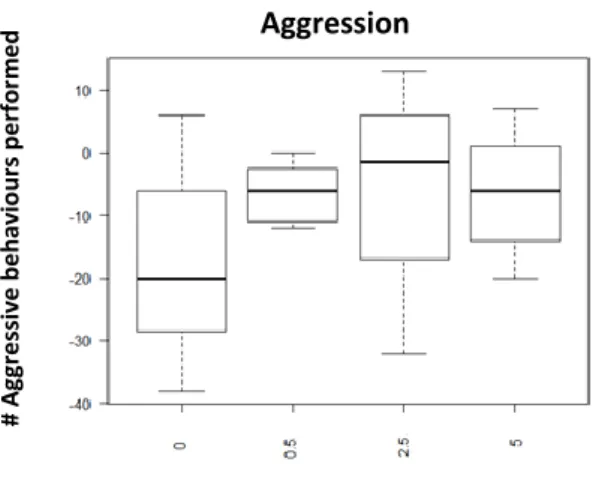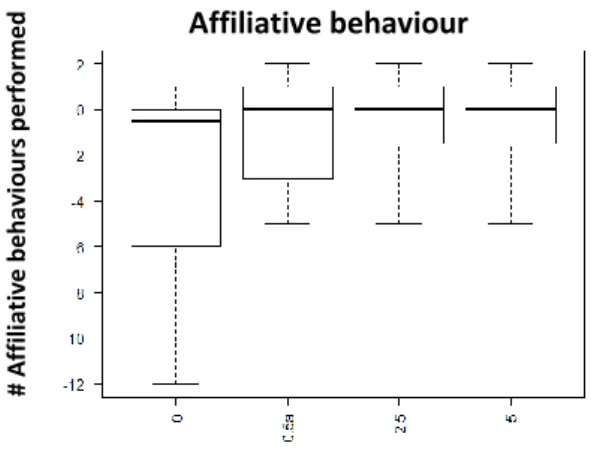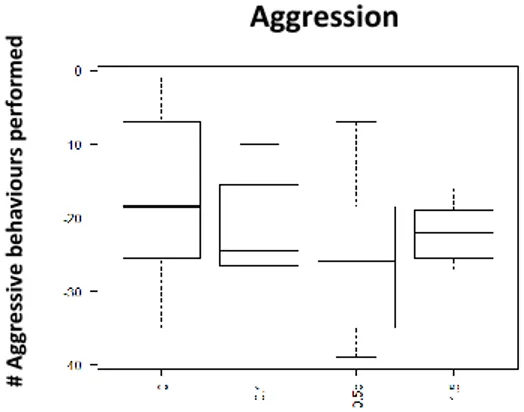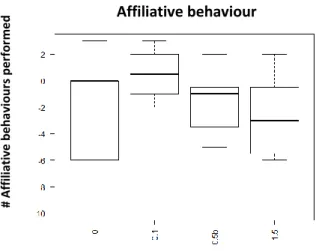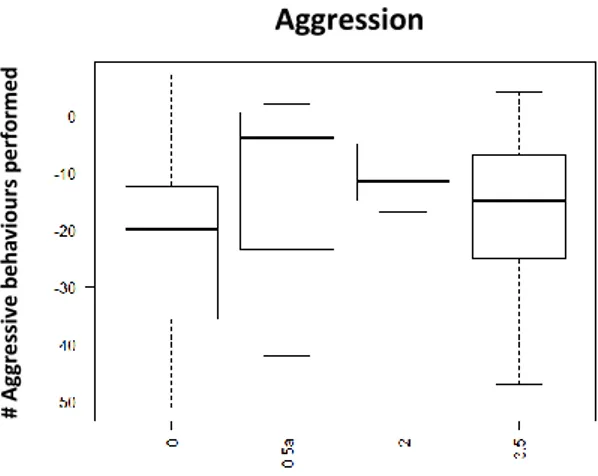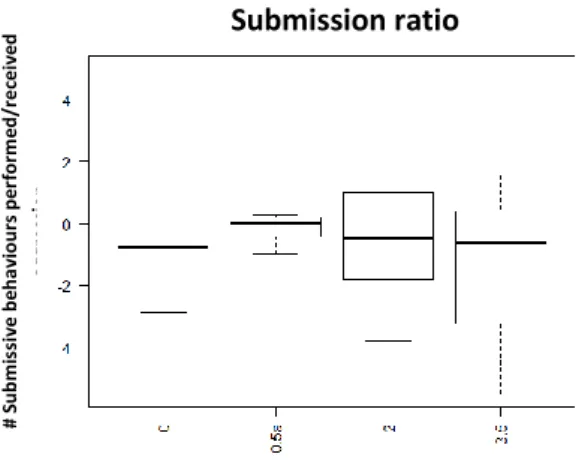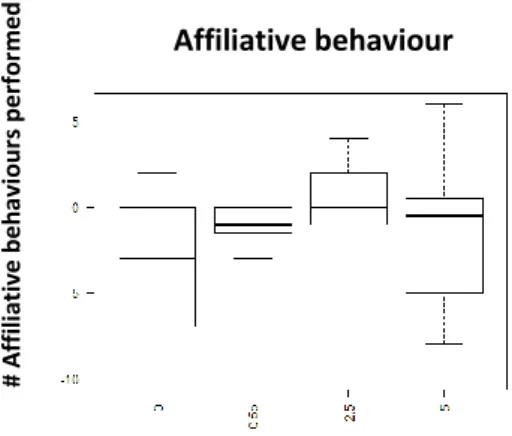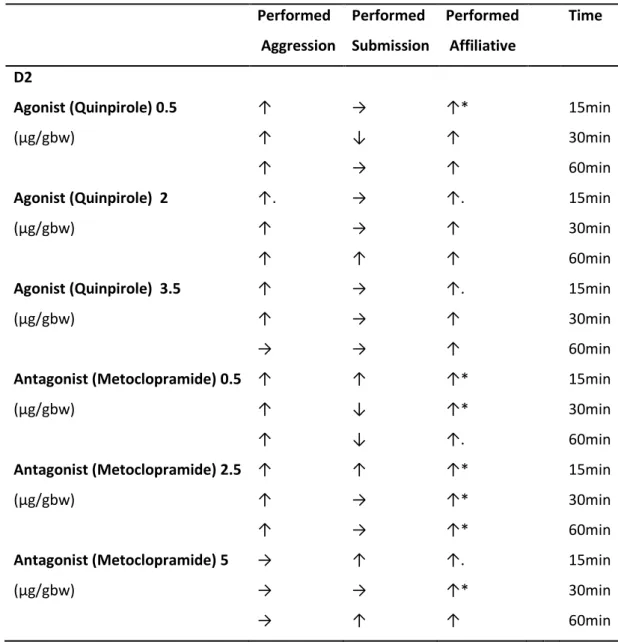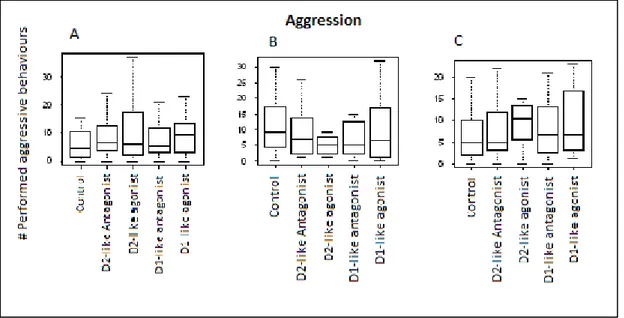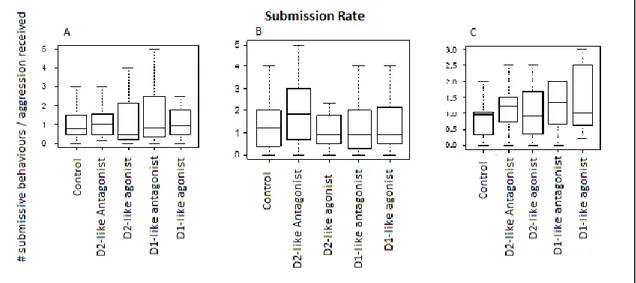2016
UNIVERSIDADE DE LISBOA
FACULDADE DE CIÊNCIAS
DEPARTAMENTO DE BIOLOGIA ANIMAL
The role of dopamine for behaviour regulation in cooperatively
breeding fish
Mestrado em Biologia Evolutiva e do Desenvolvimento
Diogo Fazenda Antunes
Dissertação orientada por:
Professor Dr. Michael Taborsky
Professora Dra. Susana Varela
2
Índex
Resumo _____________________________________________________________________ 4 Abstract ____________________________________________________________________ 7 General Introduction __________________________________________________________ 8 SOCIABILITY AND COOPERATION _______________________________________________ 8 PHYSIOLOGY OF COOPERATION ________________________________________________ 9 DOPAMINERGIC SYSTEM ____________________________________________________ 10 MODEL SYSTEM: NEOLAMPROLOGUS PULCHER __________________________________ 11 Chapter 1: The effect of different dosages of dopamine in the behavioural regulation of a cooperative breeding cichlid fish ________________________________________________ 13
Introduction ______________________________________________________________ 13 Materials and Methods _____________________________________________________ 16 Housing ________________________________________________________________ 16 Pharmacological manipulation ______________________________________________ 16 Behavioural analysis ______________________________________________________ 16 Treatments _____________________________________________________________ 17 Experimental protocol ____________________________________________________ 17 Statistical analysis________________________________________________________ 17 Results __________________________________________________________________ 19 a) D1 Treatment – Agonist _________________________________________________ 19 b) D1 Treatment – Antagonist ______________________________________________ 20 c) D2 treatment - Agonist __________________________________________________ 23 d) D2 antagonist _________________________________________________________ 24 Discussion ________________________________________________________________ 27 2nd Chapter – The influence of the dopaminergic system to N. pulcher behavioural regulation: social Context manipulation ____________________________________________________ 29
Introduction ______________________________________________________________ 29 Materials and Methods _____________________________________________________ 31 Housing ________________________________________________________________ 31 Pharmacological manipulations _____________________________________________ 31 Behavioural analysis ______________________________________________________ 31 Experimental set-up ______________________________________________________ 32 Statistical Analysis _______________________________________________________ 32 Results __________________________________________________________________ 33 Discussion ________________________________________________________________ 37
3
3rd Chapter – Dopamine Concentration in the macro-areas of the Brain _________________ 40 Introduction ______________________________________________________________ 40 Materials and Methods _____________________________________________________ 42 Housing and experimental design ___________________________________________ 42 Sampling _______________________________________________________________ 42 Analysis of brain Dopamine and metabolites __________________________________ 42 Statistical analysis________________________________________________________ 43 Results __________________________________________________________________ 44 Whole brain analysis _____________________________________________________ 44 Brain macro areas analysis _________________________________________________ 45 Discussion ________________________________________________________________ 48 General Discussion and Final Remarks: The influence of environmental change to dopaminergic activity ____________________________________________________________________ 50 Acknowledgments ___________________________________________________________ 52 References _________________________________________________________________ 53 Supplementary information: 1st Chapter _________________________________________ 59 Supplementary information: 3rd Chapter __________________________________________ 63
4
Resumo
Este estudo tem como objectivo compreender o papel de um neurotransmissor, a dopamina, na regulação de comportamentos sociais e cooperativos. Para uma melhor compreensão de cooperação, é necessário compreender primeiramente o que é sociabilidade. Sociabilidade pode ser definida pela vivência de dois ou mais indivíduos como parte do mesmo grupo. Para a sociabilidade ocorrer, é ainda necessário, existir interacção entre os membros do grupo, tendo sempre em conta o contexto social em que a interacção ocorre, assim como o comportamento do indivíduo com o qual a interacção está a ocorrer. Após a percepção destes dois componentes cada membro do grupo terá que modelar o seu próprio comportamento para que a que a sua acção se enquadre ao que lhe é exigido pelo contexto social em que se encontra. O contexto social em que um animal se encontra é definido pelo conjunto de factores ambientais (eg. taxa de predação, recurso de alimento e a forma como os seus pares se estão a comportar). Apenas após a consideração dos aspectos referidos acima, é que os comportamentos cooperativos podem emergir.
Cooperação pode ser definida como uma acção que é realizada por um indivíduo A, que por sua vez beneficia um individuo B. Dentro de comportamentos cooperativos podemos definir vários tipos de interacções dependendo do receptor do benefício resultante dessa interacção. Esta troca de benefícios é designada de reciprocidade. A reciprocidade pode ser directa, quando dois indivíduos se entreajudam, ou indirecta quando numa interacção cooperativa o indivíduo beneficiado ajuda um terceiro indivíduo.
A investigação em cooperação e sociabilidade que tem sido desenvolvida têm-se focado maioritariamente na ecologia mas também nos aspectos evolutivos de como cooperação e sociabilidade poderá ter surgido e mantida ao longo do tempo. Contudo, pouco se conhece sobre os seus mecanismos regulatórios.
O presente estudo pretende desvendar o papel de um neurotransmissor na regulação de comportamentos cooperativos e sociais, a dopamina.
Dopamina é uma catecolamina que está envolvida em várias funções centrais de um organismo, tal como na locomoção, na cognição, na aprendizagem e no sistema mesolímbico de recompensa.
Em 2011 foi descrita a “Social decision-making network” que consiste num conjunto de núcleos cerebrais que estão envolvidos na regulação de sociabilidade, tal como o núcleo accumbens e a área pré-óptica, juntamente com o sistema mesolímbico de recompensa também está incluído na “Social decison-making network”. Admite-se desta forma, que um comportamento social para ser repetido, é porque despoletou alguma recompensa num “helper” (ajudante).
Tendo isto em conta o presente estudo tem como principal objectivo tentar uma melhor compreensão do papel da dopamina na regulação comportamentos sociais e cooperativos. Compreender de que forma a dopamina regula comportamentos cooperativos e sociais de ”helpers”.
Foi usado como objecto de estudo, o ciclídeo Neolamprolugus pulcher, sendo que esta espécie vive em famílias com uma estrutura social robusta. Estas famílias são constituídas por um casal dominante e um conjunto de “helpers” que varia de um a trinta, em que apenas o par dominante se reproduz. Os ajudantes podem ser indivíduos sexualmente maturos ou não, o seu papel na família consiste em defesa do território contra predadores e intrusos,
5
manutenção do território e a ajudar a criar a ninhada dos dominantes. Os predadores podem ser predadores de ovos ou de adultos.
Para este efeito foram realizadas injecções intramusculares em indivíduos ajudantes, com agonistas e antagonistas específicos para receptores D1 e D2. Após a manipulação da actividade de cada um destes receptores realizou-se observações de forma a serem detectadas diferenças comportamentais (eg. número de comportamentos agressivos, submissos e de afilação).Para melhor compreensão da função dos receptores dopaminérgicos na regulação de comportamentos cooperativos e sociais em ajudantes, foram formadas 8 famílias com um casal dominante e dois ajudantes, um grande e um pequeno.
Começou-se por realizar um estudo de calibração para as dosagens das drogas em estudo, agonista de D1-like (SKF-38393), antagonista de D1-like (SCH-23390), agonista de D2-like (Quinpirole) e antagonista de D2-like (Metoclopramida).
Para a execução do estudo de calibração foram escolhidas 3 doses para cada uma das drogas, um dose alta, uma dose média e uma dose baixa, estas doses foram escolhidas tendo em conta estudos anteriores realizados noutros organismos. Como controlo foi injectada uma solução salina. Para este estudo foram criados dois grupos com 4 famílias cada, em que cada grupo apenas foi injectado com drogas para uma das classes de receptores, 4 famílias estiveram sujeitas ao tratamento para os receptores D1-like (8 ajudantes no total) e 4 famílias estiveram sujeitas ao tratamento para os receptores D2-like (8 ajudantes no total).
O desenho experimental consistiu em realizar várias sessões de observações de 15 minutos em diferentes tempos, uma observação antes da injecção, uma sessão de observação 15 minutos após a injecção, outra observação 30 minutos após a injecção e outra observação 60 minutos após a injecção.
Com este estudo foi possível concluir que os receptores D1-like e D2-like estão de facto a modular a agressividade, submissão e comportamento aflitivo dos ajudantes.
Após o estudo de calibração testou-se o papel dos receptores dopaminérgicos na regulação comportamental dos ajudantes, quando estes são sujeitos a diferentes contextos sociais. Para tal, foram usadas 10 famílias constituídas por um casal dominante e 2 ajudantes (um grande e um pequeno ajudante), a duas tarefas distintas mais uma tarefa de controlo. Estas tarefas consistiram em estimular certos comportamentos por parte dos ajudantes, tal como comportamentos de manutenção do território tal como escavar e limpar o abrigo e comportamentos de defesa contra intrusos. Para induzirmos comportamentos de ajuda na manutenção do território preenchemos o abrigo do casal com areia para induzir o comportamento de escavar por parte dos ajudantes para que estes desobstruíssem o abrigo. Para a indução de comportamentos de defesa do território foi apresentada à família um predador de ovos num tubo de apresentação, para induzir comportamentos agressivos contra o intruso por parte da família mas em especial por parte dos ajudantes.
Como controlo para as tarefas foi elaborada uma observação sem manipulação do ambiente antes e depois da injecção.
Semelhante ao que foi feito na primeira experiência foram realizados períodos de observação de 15min para cada tarefa, antes e depois da injecção.
Neste caso cada ajudante foi injectado intramuscular com uma dose de cada uma das drogas, agonista do D1-like (SKF-38393), antagonista de D1-like (SCH-23390), agonista de D2-like (Quinpirole), antagonista de D2-like (Metoclopramida), e controle (solução de 0.9% NaCl).
6
Esta experiência permitiu demonstrar que os receptores D2-like estão de facto a regular a agressividade, submissão e afilação em ajudantes de N.pulcher, no entanto foi observado que esta depende do contexto social a que o ajudante está sujeito. Isto porque não foi constatado um aumento no número de comportamentos agressivos em todas as tarefas apresentadas, apenas nas tarefas em que tal comportamento era contextualmente exigido (eg. Na presença de um intruso). É assim evidenciado que apesar da dopamina regular a sociabilidade de N.pulcher, especialmente os receptores D2-like, estes parecem estar a ter em conta o contexto social a que os ajudantes estão sujeitos.
Após a manipulação farmacológica dos receptores dopaminérgicos no cérebro dos ajudantes averiguou-se também de que forma a actividade dopaminérgica estava distribuída no cérebro de um ajudante. Para isso foram executadas microdissecções das macro-areas de cérebros de indivíduos ajudantes (que pertencem a uma família), e a indivíduos que não eram ajudantes (que se encontravam em tanques de agregação). Indivíduos de tanques de agregação também se encontravam dentro de uma estrutura hierárquica forte, mas no entanto esta não era uma família.
Dissecou-se as seguintes macro-areas: “forebrain”, tecto óptico, cerebelo, diencéfalo e tronco cerebral. Após as dissecções foram medidas as concentrações de dopamina e dos seus metabolitos (HVA e DOPAC), nas várias macro-areas em estudo.
Ao analisar a contracção total de dopamina e dos seus metabolitos no cérebro de ajudantes versus não-ajudantes, constatou-se a não existência de diferenças significativas entre estes. No entanto, quando analisadas as diferentes macro-areas separadamente, foi evidenciado que os ajudantes têm significativamente mais dopamina e HVA no “forebrain” comparativamente com os não-ajudantes. Considerando a concentração de DOPAC, observou-se ainda que os ajudantes têm significativamente mais DOPAC no diencéfalo e no tronco cerebral.
Estes resultados vão de encontro com estudos anteriores, que demonstram que áreas como o hipotálamo anterior estão envolvidas na regulação de comportamentos sociais, e que a elevada concentração de dopamina no “forebrain” está correlacionada com a percepção de uma recompensa. Os resultados deste estudo sugerem que os ajudantes de N.pulcher sentem uma recompensa por pertenceram a uma família. Sugerindo que, ao contrário do que se pensava anteriormente, ser um ajudante de uma família de N.pulcher é um caso de reciprocidade directa e não de um comportamento altruísta.
Palavras-chave: Sociabilidade, Cooperação, Neolamprologus pulcher, dopamina,
7
Abstract
Cooperation is an evolutionary enigma that has intrigued biologists ever since Darwin.
Much has been researched on the functional mechanisms of cooperation however; the
physiological framework has only recently become a focus. Here we report on three
experiments focussing the role of dopamine in social behaviour of a notorious
cooperatively breeding teleost fish species. Dopamine is involved in the modulation of
animals’ reward system and social decision network, suggesting that it might be
involved in sociability. We studied Neolamprologus pulcher, a cooperative cichlid fish
from Lake Tanganyika, East Africa. These fish live in families with a dominant pair and a
variable number of subordinates helping the dominant breeders in territory
maintenance and defence, showing altruistic behaviour by engaging in alloparental
care. We aimed at dopaminergic receptors D1 and D2, blocking or stimulating their
activity with injections of agonists or antagonists (SKF-3893, SCH-23390, Quinpirole
and Metoclopramide). Our data suggest that the two dopaminergic receptors have
different regulatory roles for the social behaviour of these fish. The major focus seems
to be on D2 receptor, which is influencing the aggressive, submissive and affiliative
behaviour. Specifically, the D2 receptor is stimulated there was an increase of
aggression, while when blocked it increases submission and affiliative behaviour.
Interestingly, social context is the switch in which D2 influence is observe, helpers have
into account the social context and they will not behave in discordance with the
environment. Finally, when analysing the concentration of dopamine and its
metabolites we found that helpers have a higher dopaminergic activity in the
diencephalon and a higher concentration of dopamine the forebrain (e.g.
Telecephalon). Higher levels of dopamine in helpers’ telencephalon points out towards
the direct existence of reward from living in a stabilized family. These data provide the
first insight into the role of dopamine for the social behaviour of a cooperative fish
species.
Key-words: Sociability, Cooperation, Neolamprologus Pulcher, Dopamine, D1-like
8
General Introduction
SOCIABILITY AND COOPERATION
Sociability is a term to define an interaction between two individuals that live in a group.1 In order to live in groups, its members need to gain a genetically advantage, except
in can of siblings.1 In the particular case of siblings kin-selection is responsible for their
group living, being a consequence of parental investment.1 In non kin related groups they
have several advantages for living in a group, for example it is known that in baboons, individuals that live in isolation do not survive for long due the large predation rate that exists in the environment.2 Being social does not mean that the group members cooperate,
in fact cooperation can be seen as a case of high sociability.
The term cooperation is applied to any interaction between individuals where the action of one individual benefits another 3. A large spectrum of organisms engage in this
positive trade-offs microorganisms (Lichens) as well as vertebrates (including mammals). For a long time cooperation has intrigued biologists: why should animals cooperate with each other? What is the advantage of cooperation?
In order to understand this cooperative behaviour we need look at the social structures behind it and analyse the benefits to each party involved, in particular the helper. “Helper” is the name given to the individual that benefits the other, in other words, the helper is the cooperator. An important point of analysis is whether the helper receives any pay-off from the receiver. This will allow differentiating between different ways of cooperation and biological interactions.
Cooperation interactions where the helper receives pay-off for his action can be divided in four categories, depending on the type of reward. First, there is the individual advantage, which occurs when cooperation is of advantage to the cooperator (helper). In this case, cooperation is motivated by a future benefit. For example, when an unmated male helps a mated male, in order to get his female mate when he dies4.
Second, there is reciprocation, a type of cooperation where the helper cooperates only in order to receive the same treatment in the future from others in the population. This interaction it is often described as “reciprocal altruism”5. One example of this behaviour
can be seen in vampire bats (Desmodus rotundus) which feed on mammalian blood. Sometimes, when some of the members of the population have been unsuccessful foraging, the more successful ones regurgitate to feed the unlucky ones4.
At last there are instances where animals cooperate because they are Kin with the receiver, so in those cases the helper cooperates because that will increase his own fitness. Because his genes are in the receiver, the survival of the receiver is of interest to the
9
cooperator 4. However, there are cases where the cooperator does not receive anything
from this interaction. One of these cases would be a manipulated cooperator that helps without knowing. This is what happens in brood parasitism, when the parasitic specie lays his eggs on the host nest and leaves it there for the host to brood them. One example of that is the interaction between cowbirds and cuckoos, with the cowbirds parasiting the cuckoo’s nest and the cowbirds infants mimicking the cuckoo’s children4.
Fourth, is cooperation without any pay-off to the cooperator.
PHYSIOLOGY OF COOPERATION
For cooperation to be raised bonds are needed to be formed between group members.6,7 These relationships are crucial for creating preferences where some
individuals will be treated differently, where certain behaviours will perform exclusively towards individualized partners.6
Hormones and neurohormones play a very importance role in the bonding and in regulation of the exclusive individual specific behaviours performed, having both activational and organizational influence on general social behaviour.6
One example of the importance of hormones in modulation of social behaviours is the role of androgens. Androgens act as behavioural facilitators by modulating neural pathways of social behaviour, for instance androgens can regulate aggressive and sexual behaviour in male vertebrates.6,8–11 Within a social network an individual androgen level
will modulate perceptive, motivational and cognitive mechanisms, influencing future social behaviour efficiency. 10
Hormones may modulate behavioural expression but they will not cause behaviour, behaviour is mainly driven by internal and environmental stimuli.6
Besides sex hormones, stress hormones, neuropetides and neurotransmitters can also modulate social behaviour.6
Neuropetides from vasoticin/oxytocin family can modulate social behaviours, in is known that species differences in Oxytocin receptors in the nucleus accumbens is associated with differences in matting systems.12 In prairie voles it was shown by
pharmacological manipulation of the oxytocin receptors induces the formation of partner preference.13
In cleaner wrasses (Labroides dimidiatus) it was found that arginine vasotocin (AVT) has a relevant role in reducing interspecific cleaning activities and modulates dishonesty, meaning that endogenous levels of AVT is directly modulating perceptive, motivational and cognitive mechanisms, affecting cleaning behaviours.14
10
Neurotransmitters and neuromodulators are also able to modulate social behaviour. In order to have flexible behaviours neuronal plasticity is needed, this plasticity can be achieved by chemical modulation.6 Chemical synapses allow focal modulation of
signal transmission, representing a modulation done by cell-cell signalling.6
In adult vervet monkeys (Chlorocebus pygerythrus) it was shown that by increasing central serotonergic activity with pharmacological stimulation resulted in the acquisition of high dominance status. 15
In rats it was found that dopamine and serotonin are involved in in two different types of cost-benefit decision making. Dopamine was responsible for decisions concerning effort and reward delay, while serotonin was crucial for evaluation concerned with the reward delays.16
In teleost fish it was found that serotonin is neuromodulatory driver for social and cooperative behaviours, by pharmacological blockage of the serotonin-mediated response cleaner fish have decreased the number of cheats and increased aggression towards conspecifics.17
DOPAMINERGIC SYSTEM
Dopamine is known to have a major importance in several central functions and behaviours, such as cognition, emotion, perception, motivation, reward, decision making and memory18–20. Dopamine is catecholaminergic neurotransmitter widely expressed in
the brain 21that is has been very well studied in mammals where it has been found that
dopamine has four major pathways; the nigrostriatial, mesolimbic, mesocortical and tuberoinfular systems 22,23
For the purpose of this thesis we will focus more on the role of dopamine in the mesolimbic reward system.
For the study of cooperation and sociability the mesolimbic reward system has a major role, as it was described in 2011 by O’Connell and colleagues.24 Social behaviour for
being adaptive it must be rewarding in some way.24 The dopaminergic system is
responsible giving reward from a social interaction.25
Dopaminergic signalling is mediated by five distinct receptors that are organized in two clades: D1-like receptors that include the D1 and D5 receptors, D2-like receptors including the D2, D3 and D4 receptors. These two clades are distinguished by their interaction with the enzyme adenylyl cyclase (AC) , the D1-like receptors activate AC while the D2-like receptors inhibits it.21
It is known that these two clades of dopaminergic receptors have different affinities to dopamine, having the D2-like receptors close to 10-to-100-fold greater affinity
11
than the D1-like receptors26,27. Furthermore the D1-like receptors have a higher
concentration postsynaptically, while the D2-like receptors can be found bout pre- and postsynaptically being mainly autoreceptors.26
The D2-like receptors can inhibit dopaminergic neuron firing, synthesis and release inducing a negative feed-back 27, while the D1-like receptors have a direct
stimulation.
In 2011 O’Connell and colleagues have described the Social decision-making network (SDM).24 In this study they took into account the Social Behaviour network
described by Newmann in 1999,28 but O’Connell added the mesolimbic reward system to
the Social Behaviour network. O’Connel argued that a social behaviour should be some way rewarding in order for it to be continuous or repeated.24 In the Social Behaviour
network that was previously described it already included some brain nuclei that also belong to the mesolimbic reward system, such as the lateral septum (LS) and the bed nucleus from stria terminalis (BNST)/medial amygdala (meAMY).
With this network we can understand how crucial the dopaminergic system is for the regulation of social behaviour.
In cynomolgus monkeys it was shown the importance of the D2/D3 receptors availability for social rank formantion.29,30
In rats it has been shown by pharmacological manipulation that the blockage of the D2-like receptors increases aggression, while blockage of the D1-like receptors decreases aggression.31 In praire voles was found that the D2-like receptors are responsible for pair
bonding and partner preference.32,33
In teleost it was also shown the importance of the dopaminergic system in aggression 34–36. In Artic charr it was shown that subordinate fish have lower
dopaminergic activity which associated in recuduction of aggression.36 In cleaner wrasses
it was found that the D1 receptors are responsible for reward perception, perception of cost/benefits in an interaction with the clients, and in learning. 37,38 In cichlid fish
(Aequidens pulcher) it was found that the administration of dopamine agonists and antagonist reduced aggression.39
MODEL SYSTEM: NEOLAMPROLOGUS PULCHER
For better understanding the role of dopamine in social behaviour regulation we used the cooperative breeder specie Neolamprologus pulcher. This cichlid fish from the Lake Tanganyika lives in social groups inside of rocky habitats near the sublittoral zones of the lake (Poll 1974)40. These social families or groups usually consist of a pair of
12
dominant breeders and a variable number of subordinates of different size. On average the groups have between 5 to 6 helpers with ≥ 15mm standard length. However, the number of helpers can vary from 1 to 30 helpers for one family41–43.
Helpers usually provide help with several chores such as brood care and defence, maintaining and improving the territory 42,44,45, both mature and immature helpers
participate.
N. pulcher’s behaviours and ecology it was studied for several years 41and most of
their behaviours have been described and catalogued (see Taborsky 1984)44. We can
divide N. pulcher’s behaviour in 6 categories: restrained aggression (fin spread, frontal approach, S-ben, head jolting); overt aggression (ramming, biting, mouth fighting); affiliative behaviour (bumping); submissive behaviour (tail quiver, hook display, zig-zag swimming); territory maintenance (digging, carrying, substrate cleaning); brood care (cleaning eggs, mouth-cleaning fry, fanning). 44
Behaviours such as brood care and egg defence against predators are considered as altruistic behaviours, because helpers don’t receive any direct reward from this behaviour.46
Neolamprologus pulcher has very complex social and cooperative interactions, for that reason our aim is to study the role of dopamine in the regulation of such complex interactions.
Our hypothesis is that N.pulcher’s helpers might receive a reward from being part of a family, and that dopamine is regulating N.pulcher’s interactions with the family members. For testing this hypothesis we performed pharmacological manipulations of the two clades of dopaminergic receptors, D1-like and D2-like, by injecting receptor specific agonist and antagonist of these two clades. Our interested is on the regulation of helping behaviour, interaction between helpers and dominants, for this reason our work is focus on helper’s behaviour.
We predict that dopamine will in fact be regulating social interactions in N.pulcher, confirming dopamine’s role in social decision as it was described by O’Connell. 24
We will also measure the concentration of dopamine and tis metabolites to better understand where the behavioural regulation might take place, and where do helpers have a higher dopaminergic activity. With this analysis we also aim to study if helpers perceive a reward from belonging to a family.
Has it was described by O’Connell and Colleagues in 2011, we think that a social interaction should be somehow rewarding in order to be repeated, so we are expecting to find higher concentrations of dopamine in helper’s forebrain which is a sign that they are perceiving a reward. 24,47
13
Chapter 1: The effect of different dosages of dopamine in the
behavioural regulation of a cooperative breeding cichlid fish
Introduction
Sociability and cooperation are a very complex set of behaviours, in which individuals need to have an integrative knowledge of the environment and social context in order to have an appropriate response to a given situation.6 To behave appropriately an individual needs to collect relevant information, and process the acquired information in order to behave accordingly.6 Nowadays, we have a very profound knowledge in behaviours and ecology of animals, but we still lack on knowledge about the mechanisms that are behind the integration of information.6 For this reason the following chapter is going to focus on the role of the neurotransmitter dopamine.
Dopamine it is a catecholamonergic neurotransmitter known to have a major importance in several central functions and behaviours, such as locomotion, cognition, emotion, perception, motivation, reward, decision making and memory18–20. It is also known
from studies in mammals that dopamine has four major pathways, the nigrostriatal, mesolimbic, mesocortical and tuberoinfular systems. 22,23 An abnormal dopaminergic signalling can originate a variety of brain disorders in humans, such as bipolar disorder, major depression and dyskinesia.22,48–51
Dopaminergic signalling is mediated by five distinct receptors that are organized in two clades: D1-like receptors which include the D1 and D5 receptors, and the D2-like receptors which include the D2, D3 and D4 receptors. The distinction between these two major categories is based on their interaction with the enzyme adenylyl cyclase (AC). The D1-like receptors activate AC whereas the D2-like receptors inhibit it.21 It is known that there are affinity differences of dopamine for each receptor, the D2-like receptors have a higher affinity to dopamine than the D1-like receptor family.26,27 Furthermore the D1-like receptors are in higher concentration postsynaptically, being thought that the D1A receptors have the higher
influence in vertebrates 26. On the other hand, the D2-like receptors can be found in both pre- and postsynaptically, being predominantly autoreceptors.26 This means that the D2-like receptors are able to inhibit dopaminergic neuron firing, synsthesis and release, inducing a negative feedback27, while the D1-like receptors have a direct stimulation. Thus it is expectable that D1-like receptors and the D2-like receptors to have opposite behavioural effects.52 In teleost fish it has been shown in a cichlid fish (Astotilapia brutoni) that the D1 and D2 receptors are widely expressed in the telencephalon and diencephalon and some
14
mesencephalic structures.24 These regions are known in across amniotes that involved the social behaviour regulation28,53,54, suggesting that dopamine may play an important role in social behaviour in teleost fishes.24
Skuse and Gallager showed that the dopaminergic reward system is involved in the social brain24, having a role in affiliation in the animal models25. In 2012, O’Connell and colleagues described the social decision-making network, as a combination of the social behaviour network28 with the mesolimbic reward system, which they describe as network that governs stimulus evaluation and behaviour in social organisms.24 Since our goal is to understand the underlying mechanisms in complex interactions such as sociability and cooperation we decided to use a cooperatively breeding cichlid fish, Neolamprologus pulcher as the model species for this study. N.pulcher is a cichlid fish endemic from Lake Tanganyika, one of the three big lakes in Africa known from its adaptive radiation. This fish live in rocky habitats in the sublittoral shores of the lake. They live in families with size-based hierarchy, consisting in a breeder pair and to 30 non reproductive helpers. Helpers are individuals that delay their reproductive period in order to stay in a family and help. Helpers perform alloparental care, shelter maintenance and engage territory defence against intruders.42,55–58 Several studies have manipulated pharmacologically the
dopaminergic activity in rats and fish brains6,19,59–61, although Neolamprologus pulcher was
never used for studying dopamine’s role in N.pulcher’s social behaviour. For this reason, and considering that receptors have distinct affinities and putative concentrations and distributions in N. pulchers brains, we deemed important to understand the role of different drug dosages. Thus, we performed a calibration study for this species in order to create a dosage/response curve. The aim of this study is to understand if dopamine and its receptors plays a role in N.pulcher’s behaviour.
This study will be mainly focus on the role of the D1-like and D2-like receptors. It is known that these two receptors types have different roles and sometimes can produce antagonistic responses. It has been shown that the effect of D2-like antagonists increases aggression in rats whereas the administration of a D1-like antagonist decreases aggressive behaviours31.In male prairie voles D2-like receptors are mediating partner
preference 33.D1-like receptors are involved in recognition memory of familiarity and
place of objects.62
In teleost fish it has been shown that the D1 receptor pathway has a greater role in reward associative learning than the D2 receptor pathway.37 Moreover It was shown that
dopaminergic blockage by administration of D1 and D2 antagonist that the dopaminergic system is involved in decision making in cooperative context.38 For this reason, this study
15
behaviour of Neolamprologus pulcher. We looked at performed aggression, submission, affiliative and maintenance behaviour. With this approach we want to create a stronger background for further experiments in N.pulcher’s system. This calibration study will establish the effect produced by several drug dosages, providing strong evidence for following up experiments.
According to the literature mentioned before, we expected to find that dopamine is modulating behaviours such as aggression and/or affiliative behaviour.
16
Materials and Methods
Housing
We used second to fourth generation offspring’s of wild caught Neolamprologus pulcher from Kasakalawe point near Mpulungo, Zambia. The fish were bred and housed at the Etologich Station Hasli, Institute of Ecology and Evolution, University of Bern.
We created 8 families with 4 members, organized in one couple and two helpers (one large and one small). All the fish had a minimum size difference of 5-10mm Standard Length (SL) between fish from different ranks. The families were kept in 50L tanks with two shelters and one refuge per tank. With a light: dark cycle of 13:11 at a room temperature of 27°C. All the fish were feed 6 days per week, with commercial cichlid food (tetra).
Pharmacological manipulation
Our goal in this study is to see if dopamine has a role in the cooperative and social behaviour of Neolamprologus pulcher. In order to better understand the importance of this neurotransmitter we decided to pharmacologically modulate the receptor activity. For that we used SKF-38393 (1-phenyl-7,8-dihydroxy-2,3,4,5-tetrahydro-1H-3-benzazepine) hydrochloride as D1-like receptor agonist19,21,37, and SCH-23390(7-Chloro-8-hydroxy-3-methyl-1-phenyl-2,3,4,5-tetrahydro-1H-3-benzazepine) hydrochloride as a D1-like receptor antagonist. For the like receptor activity manipulation, we used Quinpirole hydrochloride (LY 171555), an D2-like receptor agonist, and Metoclopramide (4-Amino-5-chloro-N-(2-(diethylamino)ethyl)-2-methoxybenzamide), an D2-like receptor antagonist. These drugs will manipulate the activity of the dopaminergic receptors directly.21
For the purpose of this experiment we draw a dosage/time curve for each test drug. Tree dosages per drug were tested in accordance to previous work done with other species19,37,38,63,64
SKF-38393–0.5 µg/gbw, 2.5µg/gbw, 5.0µg/gbw; SCH- 23390–0.1µg/gbw, 0.5µg/gbw, 1. 5µg/gbw; Quinpirole – 0.5µg/gbw, 2.0µg/gbw, 3.0µg/gbw;
Metoclopramide - 0.5µg/gbw, 2.5µg/gbw, 5.0µg/gbw. . As control solution we used a saline solution (0.9% NaCl).
All the injections had a volume of 15µl per gram of body weight.
Behavioural analysis
The number of aggressive behaviours performed by the focal helper were recorded, which included: overt aggression (i.e., with body contact such as biting, ramming, mouth-fighting) and restrained aggression (i.e. Fin spread and Opercula spreading). We also recorded the number of submissive behaviours (i.e. tail quiver) previous to aggression received by the focal helper, in order to make a ratio of submission performed per received aggression. Submission was usually towards a dominant (that may be any of the breeding pair or a larger helper) in order to stop the running attack and showing their subordinate position in hierarchy. Finally, we recorded affiliative behaviour, such as bumping (i.e. soft-touching the body of the recipient).
17
Treatments
For this experiment we decided to divide the pharmacological manipulation in two treatments. 8 families were split into two equal groups (8 helpers per treatment). The first group of families was tested on the the D1-like receptors and was injected with three different dosages of SKF-38393, SCH-23390, plus the saline solution. The second group of families was tested on the D2-like receptors and was injected with three different dosages of Metoclopramide and Quinpirole, and the saline solution.
Experimental protocol
During this experiment, all fishes were observed before and after the injection. Every behavioural observation period lasted for 15 minutes. Every observation was done using Observer 5.0 © (Noldus Information Technology). During the observation we noted each focal fish’s behaviours, its social interactions and with whom it interacted. We had four different observational time points: before the injection, then at 15 min, 30 min and 60 min after injection.
At the beginning of the experiment we filled up the shelters with sand to stimulate digging behaviour, in order to see shelter maintenance behaviour by the helpers.
All tested fishes were measured, weighted, sexed and anesthetized with KoiMed© Sleep (0.15mL for a 300mL water anaesthesia recipient) before injection. The injections were done using 0.5mL insulin syringes (0.5mL M YJECTOR, Terumo Medical Corporation, Elkton, MD 21921, USA). The fishes were injected with 15µL/gbw 17.
After the injection the fishes were inserted in a recovery box with an air stone to recover from the anaesthesia. After the focal fishes were fully recovered from the anaesthesia, they were put back into their home tank, but kept inside of isolation net until the first behavioural measurement. For all the tested fishes we waited three to four days in between injections, depending on the stability of the test family. If one of the helpers was found evicted from the group or dead, that helper was replaced by another fish with the same size and sex. After the new helper had been accepted and the family had stabilized we proceeded with the experiment.
All assays were performed during the same time of the day (10am-20pm) to control for the normal circadian variation of the neurotransmitter and daily behaviour variation of the fish.
Statistical analysis
All tests and plots were done using the software R (R Core Team, 2015 Vienna Austria) implemented in the user interface software RStudio© Version 0.98.1091 (2009-2014 RStudio, Inc).
We analysed the two treatments separately, since the fish was only exposed to a single treatment. Our experiment includes repeated measurements which we accounted for by defining fish identity as a random variable in our models. We started our analysis by subtracting the measurements before the injections as a baseline for all of the recorded behaviours. After this we log transformed our data to fulfil the assumption of normality.. We
18
used package “lme4” for general linear mixed models (GLMM) analysis. In our models, we used the frequencies of performed behaviours such as aggressive, submissive, and affiliative or maintenance behaviour as dependent variable. As fixed factors, we used the different test drugs, such as SKF- 38393, SCH-23390, Quinpirole or Metoclopramide. For this we created subsets from the original treatment file, D1 treatment or D2 treatment. Our data was normalized by the log transformation, so we assumed in our model the normal distribution.
19
Results
a) D1 Treatment – Agonist
Analysing the results from the D1 treatment, the effect of D1 agonist in aggressive behaviour is increasing with the dosage (0,5ug/gbw value =0.514; 2,5 ug/gbw p-value=0,0654 0,5ug/gbw p-value <0,005 at 30 min; See Fig.1; See Supplementary information: S.I.Table 1). Indeed, aggression output is higher when animals were injected with 5ug/gbw, while the effect is observed 15min after injection (p-value=0,0668; See table 1; See Supplementary information: S.I.Table 1) but it is higher 30min after injection as it seems to decrease 60min after injection (p-value=0,0633; See Table 1). We also see a trend for the lower dosage (0,5ug/gbw) which seems to be consistent through the entire experiment (15min: p-value=0,0512; 30min: p-value=0,0514; 60min: p-value=0,0950; See Table 1; See Supplementary information: S.I.Table 1). On the other hand, when we look at the performed submission it seems that the only significant effect is an early stage (15min after injection: 0,5ug/gbw: p-value=0,2274; 2,5ug/gbw: p-value<0,05; 5ug/gbw: p-value<0,05; See Fig. 2; See Supplementary information S.I.Table 1). Regarding the performed affiliative behaviour no significant effect was found, except for a trend when using the 2,5ug/gbw dosage : p-value=0,0818; See Fig.3; See Supplementary Information: S.I.Table 1) or the higher (5ug/gbw: p-value=0,0814; See Supplementary Information: S.I.Table 1) dosage.
Fig. 1: Performed aggression 30min after injection with D1-like agonist (SKF-38393); x axis: Dosages: 0- saline solution, 0,5ug/gbw, 2,5ug/gbw, 5ug/gbw; y axis: number of aggressive behaviours performed
Aggression # A gg re ssi ve b e h av io u rs per fo rm e d
20
Fig. 2: Ratio of Submission performed per received aggression at 15 min after injection with D1-like agonist (SKF 38393); x axis: Dosages: 0- saline solution, 0,5ug/gbw, 2,5ug/gbw, 5ug/gbw; y axis number of submissive behaviours performed per received aggression
Fig. 3 Performed affiliative behaviour 60min after injection with D1-like receptor agonist (SKF-38393); x axis: Dosages: 0- saline solution, 0,5ug/gbw, 2,5ug/gbw, 5ug/gbw; y axis - Number of performed affiliative behaviour
b) D1 Treatment – Antagonist
When we look to aggressive behaviour after the injection with D1-like antagonist, it seems that it is decreasing aggressiveness (See table 1); however we can only find a significant decrease of aggressiveness with the middle dosage (0,5ug/gbw; See table1; See supplementary Information: S.I.Table 2). This significant effect appears very early, 15min after the injection (p-value<0,05; See Fig.4; See supplementary Information: S.I.Table 2). This effect seems to decline with time but a trend is kept at 30min (p-value=0,567; See Table 1) and at 60min (p-value=0,0828; See supplementary Information: S.I.Table 2).
Looking at submissive behaviour, there seems to be an overall positive influence of SCH-23390. In this case, effective influence are seen in the lower (0,1ug/gbw) and middle (0,5ug/gbw) dosages (Figure 5). Also, a significant effect is found 15min after the injection, but only with the lower dosage (p-value<0,05; See supplementary information: S.I.Table2 ). 30min after injection all the dosages have a significant effect on performed submission (0,1ug/gbw:
Affiliative behaviour Submission rate # Sub m is si ve be ha vi ours pe rfo rm e d/ re ce iv e d aggr es si on # A ff ili ati ve b e h a vi o u rs per fo rme d
21
p-value<0,05; 0,5ug/gbw: p-value<0,05; 1,5ug/gbw: p-value<0,01). However, only the lower and middle dosage kept the effect until 60min after the injection (0,1ug/gbw: p-value<0,05; 0,5ug/gbw: p-value<0,05) It seems that the drug is increasing affiliative behaviour with the lower dosage (0,1ug/gbw), but only having a significant effect 15min after the injection (p-value<0,05; See Fig. 6). Moreover, it seems that the middle and higher dosage are decreasing it, but compared with the control (saline) this is not a significant reduction.
Fig. 4 Performed aggression 15min after injection with D1-like antagonist (SCH-23390); x axis: Dosages: 0- Saline solution; 0,1ug/gbw; 0,5ug/gbw; 1,5ug/gbw; yaxis- number of performed aggressive behaviours
Fig. 5 Ratio of performed submission per received aggression 15 min after injection with D1-like antagonist (SCH-23390); x axis: Dosages: 0- Saline solution; 0,1ug/gbw; 0,5ug/gbw; 1,5ug/gbw; y axis- number of performed aggressive behaviours Aggression Submission rate # A gg re ss iv e b e ha vi ours p e rfo rm e d # S ub mi ssi ve be ha vi o ur s pe rf o rm e d/r e ce iv e d ag gr e ss io n
22
Fig. 6 Performed affiliateve behaviour 15min after injection of D1-like antagonist (SCH-23390) ); x axis: Dosages: 0- Saline solution; 0,1ug/gbw; 0,5ug/gbw; 1,5ug/gbw; y axis- number of performed aggressive behaviours Table 1 Summary chart results from D1-like receptor manipulation- ↑- increasing; ↓- decreasing; →- no effect. *- significant effect; .- trend.
Performed aggression Performed Submission Performed Affiliative Time D1 Agonist (SKF-38393) 0.5 ↑. ↑ ↑ 15min (µg/gbw) ↑. ↑ → 30min ↑. → → 60min Agonist (SKF-38393) 2.5 ↑. ↑* ↑ 15min (µg/gbw) ↑. → ↑ 30min ↑ → ↑. 60min Agonist (SKF-38393
)
5 ↑. ↑* → 15min (µg/gbw) ↑* → → 30min ↑. → ↑. 60min Antagonist (SCH-23390) 0.1 ↓ ↑* ↑* 15min (µg/gbw) ↓ ↑* ↑ 30min ↓ ↑* ↑ 60min Antagonist (SCH-23390) 0.5 ↓* ↑* ↑ 15min (µg/gbw) ↓. ↑* → 30min ↓. ↑* ↑ 60min Antagonist (SCH-23390) 1.5 ↓ ↑ ↓ 15min (µg/gbw) ↓ ↑* → 30min ↓ ↑ ↓ 60min Affiliative behaviour # A ff ili ati ve b e h a vi o u rs per fo rme d23
c) D2 treatment - Agonist
No significant effects were found on aggressive and submissive behaviour by the D2 agonist treatment. However visual display of dosage response curve, concerning aggression shows an increase on aggression between the dosages 0,5 and 2ug/gbw, followed by a decrease with the dosage 3,5ug/gbw (See Fig.7; See Table 2; See Supplementary information: S.I.Table 3). For submissive behaviour there was a decrease between the 0,5ug/gbw and 2ug/gbw dosages (See Fig.8; See Table 2; See supplementary information: S.I.Table 3), and then an increase on preformed submission on 3,5ug/gbw dosage (See Table 2; See supplementary information: S.I.Table 3).
In terms of affiliative behaviour, the D2-like agonist seems to have an overall effect in increase it; however, its effect seems to decrease as the dosage increase (Fig .9). A significant effect was solely found when using the lower (0,5ug/gbw) dosage 15min after the injection (p-value<0,05; See supplementary information: S.I.Table 3). However, a trend was found with the middle (2ug/gbw: p-value=0,0871; See supplementary information: S.I.Table 3) and higher dosage (3,5ug/gbw: p-value=0,0871; See Supplementary information: S.I.T3) as well.
Fig. 7 Performed aggression 15min after injection with D2-like agonist (Quinpirole); x axis: Dosage: 0- Saline Solution; 0,5ug/gbw; 2ug/gbw;3.5ug/gbw; yaxis- number of aggressive behaviour
Aggression # A gg re ss iv e b e ha vi ours p e rfo rm e d
24
Fig. 8 Ratio of performed submission per received aggression 15min after injection with D2-like agonist (Quinpirole); x axis: Dosage: 0- Saline Solution; 0,5ug/gbw; 2ug/gbw;3.5ug/gbw; yaxis- number of submissive behaviour performed per receive aggression
Fig. 9 Performed affiliative behaviour 15min after injection with D2-like agonist (Quinpirole); x axis: Dosage: 0- Saline Solution; 0,5ug/gbw; 2ug/gbw;3.5ug/gbw; yaxis- number of affiliativebehaviour performed
d) D2 antagonist
Regarding the influence of the D2 antagonist, we were unable to find significant differences in aggression (Fig.10; Table 2; See supplementary information: S.I.Table 4) or submission (Fig.11; Table 2; See supplementary information: S.I.Table 4). However, affiliative behaviour had a similar effect than the one observed when injected with the agonist (Quinpirole): with the lower (0,5ug/gbw: p-value<0,05; See Supplementary information: S.I.Table 4) and middle dosage (2,5ug/gbw: p-value<0,05) which shows more consistent and lasting effect (kept for 60min)(See Table 2).
In general blocking the D2-like receptors seems to have an effect on affiliative behaviour (increasing it) when compared with the control (Fig.12). This effect is kept for 60 min with the lower and middle dosages (0,5ug/gbw; 2,5ug/gbw; See Table 2).
Submission ratio Affiliative behaviour # S ub mi ssi ve be ha vi o ur s pe rf o rm e d/r e ce iv e d ag gr e ss io n # A ff ili ati ve b e h a vi o u rs per fo rme d
25
We did not find any effect in maintenance behaviour, such as digging, in either treatment; we could not test because of the lack of maintenance behaviours.
Fig. 10 Performed aggression 15min after injection with D2-like antagonis (Metoclopramide); x axis: Dosage: 0- saline solution; 0,5ug/gbw; 2,5ug/gbw/5ug/gbw; yaxis - number of performed aggressive behaviours
Fig. 11 Rate of performed submissive behaviours per received aggression 15min after injection with D2-like antagonist (Metoclopramide); x axis: Dosages: 0- saline solution; 0,5ug/gbw; 2,5ug/gbw/5ug/gbw; yaxis - number of performed submissive behaviours per received aggression
Fig. 12 Performed affiliative behaviour 60min after injection with D2-like antagonist (Metoclopramide); x axis: Dosage: 0- saline solution; 0,5ug/gbw; 2,5ug/gbw/5ug/gbw; yaxis - number of performed affiliative behaviours
Aggression Submission rate Affiliative behaviour # A gg re ss iv e b e ha vi ours p e rfo rm e d # S ub mi ssi ve be ha vi o ur s pe rf o rm e d/r e ce iv e d ag gr e ss io n # A ff ili at iv e beh a vi o u rs p er fo rmed
26
Table 2: Summary chart results from D2-like receptor manipulation- ↑- increasing; ↓- decreasing; →- no effect. *- significant effect; .- trend.
Performed Aggression Performed Submission Performed Affiliative Time D2
Agonist (Quinpirole) 0.5 ↑ → ↑* 15min
(µg/gbw) ↑ ↓ ↑ 30min
↑ → ↑ 60min
Agonist (Quinpirole) 2 ↑. → ↑. 15min
(µg/gbw) ↑ → ↑ 30min
↑ ↑ ↑ 60min
Agonist (Quinpirole) 3.5 ↑ → ↑. 15min
(µg/gbw) ↑ → ↑ 30min
→ → ↑ 60min
Antagonist (Metoclopramide) 0.5 ↑ ↑ ↑* 15min
(µg/gbw) ↑ ↓ ↑* 30min
↑ ↓ ↑. 60min
Antagonist (Metoclopramide) 2.5 ↑ ↑ ↑* 15min
(µg/gbw) ↑ → ↑* 30min
↑ → ↑* 60min
Antagonist (Metoclopramide) 5 → ↑ ↑. 15min
(µg/gbw) → → ↑* 30min
27
Discussion
Building on the key influence of dopamine on animals’ decision-making processes we aimed to find out more on its general effect in the context of cooperation. Research on fish is limited to few species 37,38 but none on the notorious cooperative breeder N pulcher. We first aim to draw a dosage/response curve for all the test drugs, agonist (SKF-38393) and antagonistic (SCH-23390) drug of D1-like receptors, and agonist (Quinpirole) and antagonist (Metoclopramide) of the D2-like receptor. This would allow us to know how the drugs are affecting fish behaviour, namely on aggression, submission, affiliative and maintenance behaviours, depending on the dosage. Overall we found that the two families of dopamine receptors have very distinct roles in behavioural regulation. In a constant environment, we saw that the D1-like receptors are modulating aggression and submission. The D2-like receptors seem to be modulating affiliative behaviour; however, pharmacological manipulation revealed that both agonist and antagonist produced increased behavioural performance.
Our D1-like receptor manipulation showed that independently of the dosage, there is an increase of the drug effect in N. pulcher’s behaviour (i.e. aggression and submission) over time, more concretely, from the 15min to the 30min after injection. Overall, we begin to see a small decrease on the drug effect solely 60 min after the injection. The D1-like agonist is increased significantly the amount of aggressive behaviour, and submissive behaviour. Indeed, stimulating the D1-like receptors increased aggression with all the test dosages; however the higher dosage (5ug/gbw) was able to produce a significant increase of aggression, when compared to the control. Accounting for submissive behaviour, we also found that the D1-like receptor is generally increasing submission, although we found a significant difference with the middle (2,5ug/gbw) and higher dosage (5ug/gbw). Thus, the higher dosage of D1 agonist is having an effect both in aggression and submission.
As expected, the pharmacological blockage of the D1-like receptors was found to decrease aggression in N. pulcher in a stable environment, however only the middle dosage (0,5ug/gbw) revealed to have a significant effect. This effect on aggression could be seen 15min after the injection. When analysing submissive behaviour in relation to D1 blockage, we found a similar effect than the one observed in under effect of the D1-like agonist, but this time, it was the middle dosage (0,5ug/gbw) that produced an increase on submission thought the entire experiment.
In teleost fish, it has been shown that stimulating pharmacologically the activity of the D1 receptors in cleaner wrasses (Labroides dimidiatus) increases the number of inspection done to their clients. While blocking the D1 receptor leads to an increase of the tactile
28
stimulation of their clients. Showing that dopaminergic system has a role in intraspecific cooperation.38
Regarding the D2-like receptors manipulation we found that its stimulation leads to an increase on affiliative behaviour performed, from a general view. Only the lowest dosage of D2-like receptor agonist (0,5ug/gbw) produced a significant increase 15min after injection. We could not find any other relevant effect of D2-like receptor stimulation in a stable environment. For this reason we think that further investigation should be used the lowest dosage of D2-like receptor agonist.
Concerning the D2-like receptor antagonist we found the same general increase on affiliative behaviour, however we found a stronger effect, this because we found significant increases in all the test dosages. We found significant and lasting effect in both lower (0,5ug/gbw) and middle (2.5ug/gbw) dosages, however decided to use the lowest dosage because as it can be seen in table 2 this dosage seem to decrease submission, even though there was no significant effect. Our results in the D2-like receptors are in agreement with the results from Aragona and colleagues. In their study in prairie voles, they found that when D2-like receptors of the nucleus accumbens shell are activated pharmacologically, the males prefer to spend more time in contact with a familiar mate. 33
In teleost fishes it has been shown that the blockage of the D2 receptors increases the amount of tactile stimulation done the cleaner wrasses to their clients, meaning that the dopaminergic system was modulating their perception.38
With these results we can conclude that as expected dopamine plays a role in the way the individuals from a family interact with each other by modulating aggressive behavior and affiliative behavior. Further studies are needed to understand how this works when the helpers are in different social contexts, where in the brain this is happening and whether there are differences in dopaminergic activity in the brain regions from the Social decision-making network.
29
2nd Chapter – The influence of the dopaminergic system to N.
pulcher behavioural regulation: social Context manipulation
Introduction
Cooperation can be considered as higher level of sociability. Cooperation can be defined as any behaviour that an individual does in order to benefit directly or indirectly another individual B. In some cases, cooperation can be based on direct or indirect reciprocity
65
. Reciprocity considers the benefit transaction that happens between individuals from a group. Direct reciprocity occurs when the action from the individual A directly benefits another individual B. Alternatively, indirect reciprocity takes place when the action from the individual A does not directly benefit the individual B but another individual C, which in turn will directly benefit individual B. For example: A helps C, and because C was helped before he will help B, creating a “helping chain”. 3,5
This “helping chain” can influence the social environment of the group. Of course the survival of helping always depends on the benefits/costs of helping itself and whether this behaviour is the best fitted strategy. This brings us to a new topic of game theory: the theoretical analysis how the two strategies of being cooperative or non-cooperative can co-exist in nature.
First of all, in order to understand what social environment/ context is, we need to take into account the animal ecology, its group composition, as well as their interactions within the group. When we talk about ecology, we should focus on the relationship between predator-prey interactions and resource availability. How does the focal animal act when facing a predator and/or an intruder invade his territory? Different social contexts have different behavioural demanding’s; for instance, an individual behaves more aggressively when facing a predator or an intruder because the social context demands it. If the subject judges its social context incorrectly and performs misfit behaviours, that can bring loss of territory or even death of the subject. The concept of reciprocity can also be applied to subjects living in groups. Here, misfit behaviour can lead to expulsion from the group, bringing a consequent loss of recourses and vulnerability. 29,66,67
In the previous chapter we started investigating the role of dopamine in the social behaviour of a highly social organism the N.pulcher. In this chapter we will continue to analyse it, also taking into account the social context that the helpers are in.
Dopamine it is a neurotransmitter that’s very widely spread through the brain. 21 Dopamine takes action on the neural circuitry through a considerably slow modulation of the fast neurotransmission mediated by glutamate and GABA. 22
There are two clades of dopaminergic receptors: the D1-like receptors and the D2-like receptors. These two clades were created to distinguish between the dopamine receptors that modulate adenylyl cyclase differently. In fact, while the D1-like receptors (D1 and D5)
stimulate the production of adenylyl cyclase, the D2-like receptors inhibits it.21,22 It is known that the D1-like receptors and the D2-like receptors have different dopamine affinity; the D2-like receptors have 10-to-100fold higher affinity to dopamine than the D1-like receptors.22,26
30
The D2-like receptors activity can induce a negative feed-back that can inhibit
dopamine neuron firing, synthesis and release27 and then modulating D1-like receptors direct stimulating effect.
It is known that dopamine it is involved in sociability by taking part of the social-decision making network28,68,69. This network consist in a group of nuclei from different brain macro areas, such as the Nucleus accumbens, the prefrontal cortex, the medial nucleus of the amygdala and the ventral tegmental area, are connected with one another and regulate social behaviour. 24
In 2016 Messias and colleagues have shown in cleaner wrasses (Labroides dimidiatus) that the modulation of dopaminergic activity modulates their learning ability, perception of reward and evaluation of cost/risks in a cooperative interaction with their clients.37,38
In the previous chapter we suggest that dopamine played a role in aggression, submission and affiliative behaviour of N.pulcher. This last category of behaviour is responsible for group cohesion. In fact affiliative behaviour is what creates the bonding between individuals and it is also responsible for keeping this bond.33
In this chapter we will continue to work with the same cichlid fish N.pulcher as model system to analyse the role of dopamine in sociability and cooperation.
As introduced in chapter one, the helpers perform several tasks in order to pay-to-stay in the breeder’s territory, these talks include alloparental care, shelter maintenance and territory defence against predators and intruders. In addition to that, helpers will perform this large repertoire of cooperative behaviours according to their immediate social context. An example of this is how they will engage in more shelter maintenance when there are eggs in the territory.56,70 There also seems to be a division of labour between helpers where, for instance, large helpers will defend the territory, while smaller helpers will engage in alloparental care and shelter maintenance. This makes sense as a smaller helper is less effective in territory defence when it comes to fighting bigger fishes and predators. Interestingly, a helper attacking an egg predator has been considered as an altruistic behaviour, because helpers are directly increasing breeders’ fitness.70,71 As a matter of fact, the helper will not receive any direct benefit from fighting off an egg predator, since it is not a threat to the helper itself, but only to the eggs that belong to the breeders. The question remains whether the helpers receive some form of reward through their “altruistic cooperation”.
This chapter will explore the role of dopamine in two different social contexts: one were the helper should defend against an egg predator and one were the helper should engage in shelter maintenance behaviours. The analysis will also focus on the effect of the major types of dopamine receptors (D1 and D2), when pharmacologically modulated. We expect to see differences in the fish’ drug response depending on the new social context that they are facing.
